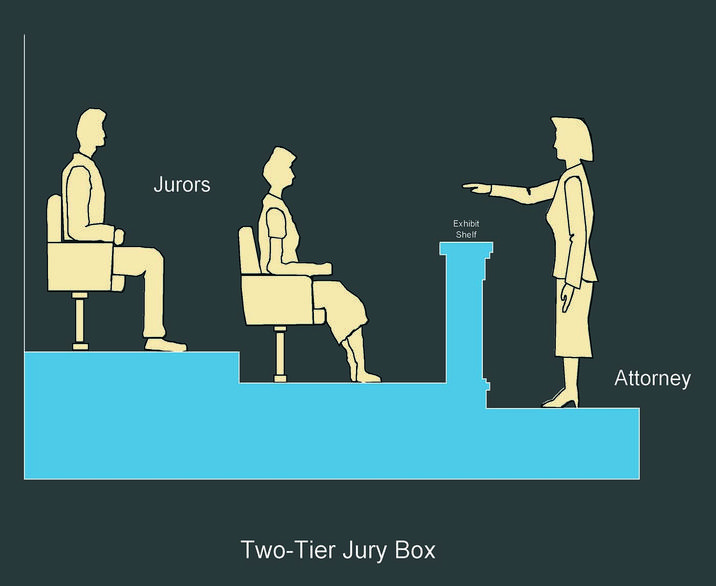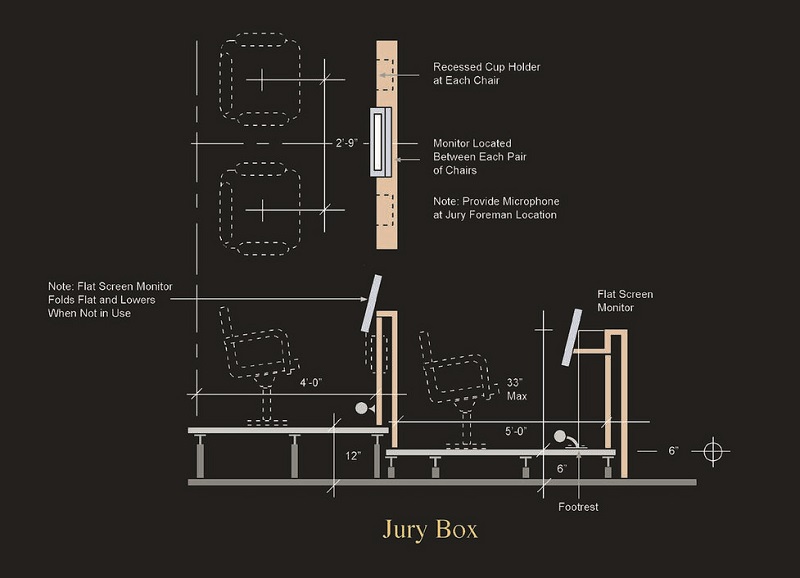Jury Box
Jurors are temporary "officers of the court" and should be afforded the comfort and courtesies appropriate to their role. They must be present and alert for long hours, often over several days. They must be protected from public contact, harassment, and intimidation. Although jury service is a civic duty required of all eligible citizens, many jurors serve at great personal sacrifice of wages and time. Many are completely unfamiliar with the judicial process and find it intimidating, confusing, and mentally taxing.
 |
The jury box may have one or two entrances. If there is a single entrance, it should be located near the exit to the jury deliberation rooms. The path should be as direct as possible and should not require jurors to cross the courtroom or exit through the spectator seating area. Access to the jury deliberation rooms should be by way of a private corridor. Jurors should not have to pass near the criminal defendant.
The jury box should be situated so that the attorneys’ tables, witness box, judge, and audiovisual exhibit area are in full view. The jurors themselves should be in view of the court and the spectators to ensure the perception of an open and public trial. The jury box is best located on the same side of the judge as the witness box, and it should not extend past either the witness box or the attorney's tables, so that there is at least a 90-degree view of all participants. All jurors should be able to see witnesses and attorneys as nearly full-face as possible.
The jury box should be far enough from the spectator area to inhibit any physical or verbal contact. Seven feet from the center of the first juror's chair to the bar separating spectators from the litigation area is adequate. A bailiff's station may be located between the jurors and the spectators to prevent any communication. Jurors should be far enough from the attorney's tables to prevent eavesdropping—a minimum of four feet to the table and six feet to the nearest attorney's chair. Jurors should not sit with their backs to the spectators; this tends to make the jurors uncomfortable and can cause distractions as jurors turn to see who may be entering or leaving.
The design and image of the jury box should be compatible with the style and finishes of the judge's bench and other courtroom furniture. The front of the jury box should be shielded with a modesty panel.
The first row of seating is traditionally elevated on one riser, and the second row elevated on two risers. This has several advantages: (1) as temporary officers of the court, the jurors receive the prominence they are due; (2) the jurors are at or above eye level of the witness, which reduces any psychological intimidation of the jurors by the witness, and (3) the jurors have a better view of the witness and the judicial proceedings.
Because of the need to make all jury boxes handicapped accessible, an option is to put the first tier at floor level, equal in height to the witness stand. This negates the need to install a ramp or lift for the jury box.
Jurors must hear the judge, witnesses, and attorneys clearly. They should have unobstructed sight lines to the judge, witness, attorneys, and exhibit area. Lighting should be of standard courtroom intensity.

Jury seats should be fastened to the floor; they should swivel but not rock and should be spaced approximately 30 to 33 inches apart nor closer than three-and-a-half feet back-to-back. Chairs should have armrests and be constructed to lessen juror fatigue during long periods, with adequate back support and legroom.
A foot-rail may be desirable. Depending upon jurisdictional restrictions, writing surfaces also may be included for each juror. Wall surfaces behind the jurors should be easily cleaned.
The jury box should include one accessible wheelchair space, located within the defined area of the jury box; access to this wheelchair space shall coincide with the circulation path provided for all persons using the jury box. If this wheelchair space is located on a tier within the jury box, a permanent ramp or lift, located on the circulation path used by all jurors, may be used to access this space.
it may be more efficient to leave the first tier of the jury box at floor level, particularly if a three‑tier box is to be used. Audio jacks for earphones or other assistive listening devices should be available at several positions for use by the hearing impaired.
The jury box should incorporate a modesty railing/panel and shelf area to provide some distance from trial participants. A bailiff or court deputy may be stationed between the jury box and the spectators to prevent any communication or intimidation. Court rules and procedures often forbid cameras to focus on jurors. If video or closed-circuit television cameras are used, jurors should be out of the cameras' view.
The jury box should accommodate all jurors plus two or more alternates. The standard jury box should accommodate 16 jurors in order to provide maximum flexibility for present and future trials. Seating placement can vary, but a two-tiered configuration is usually most efficient. Space should be provided for a handicapped juror either with an open space on the end of the first row or by removing the first juror's chair. In 6‑person jury arrangements, space should be provided for eight chairs to include two alternate positions. Jurisdictions using an 8-person jury may find it advantageous to use a 14-person jury box to provide adequate circulation in the litigation area and greater flexibility in the ability to conduct future criminal trials.
The jury box should allow ten to twelve square feet per juror. A 14-person jury box would typically be 19 to 21 feet long and eight to nine feet deep; a seven-person jury box would be four to five feet deep. The distance from the first row to the front railing should be approximately eighteen inches to allow for leg room. The modesty railing/panel should be high enough to shield the lower level of jurors. The total requirement for a 16‑person jury box is approximately 180 to 210 square feet; for an eight-person jury box, 80 to 90 square feet.
A nine- or ten-inch shelf may be desirable as part of the jury box for examining documents and exhibits, and to ensure a non-encroachment distance between the jurors and attorneys.
The jury box may be equipped with electrical receptacles and cable conduits for built-in video display monitors. A microphone may be placed near the jury foreman position.